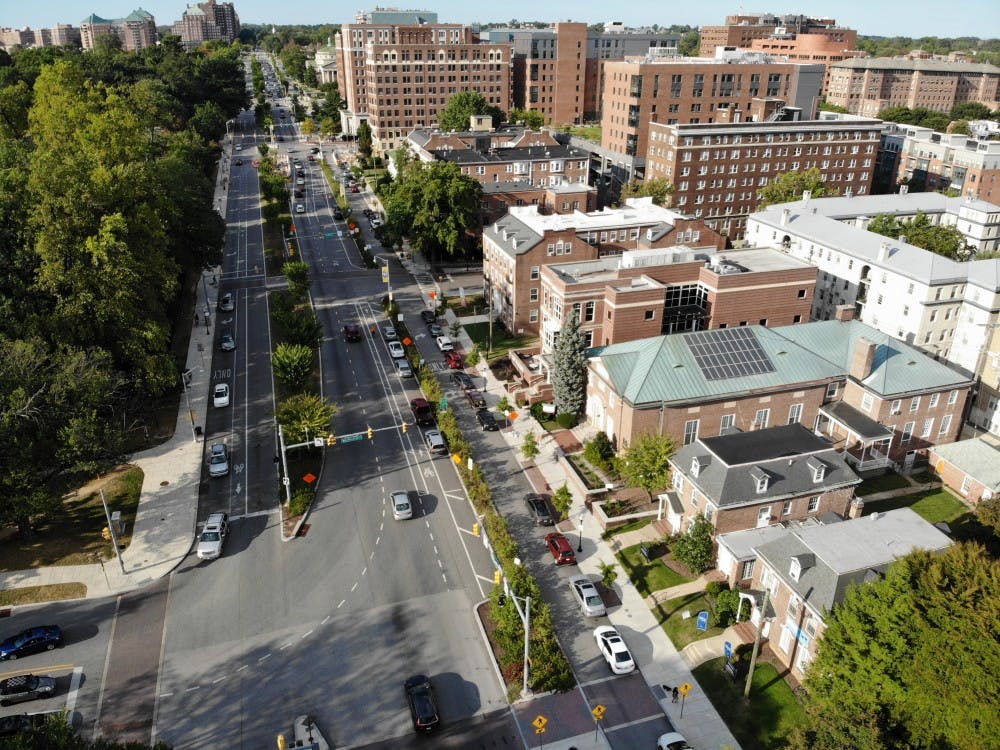University President Ronald J. Daniels visited Johnston Square, a neighborhood in East Baltimore, on Sept. 7, just as the Hopkins Live Near Your Work (LNYW) program is expanding to encompass more eastern and central Baltimore neighborhoods.
Launched by Hopkins in 1997, LNYW is a public-private partnership between the City of Baltimore and now more than 100 private employers in the city that provides grants to employees working in Baltimore City who agree to purchase a home in the city near their place of work.
In a Sept. 9 email to the Hopkins community, Daniels explained why he felt that it was important to have gone to Johnston Square and met with the community there.
“These were people dedicated to not simply imagining a better future for Baltimore but realizing it — one house, one block, one neighborhood at a time,” Daniels wrote. “We were there to mark the expansion of the Johns Hopkins Live Near Your Work program, which offers grants to our employees, many of whom now rent but want to own a home in the neighborhoods where they live and work.”
He went on to elaborate on the improvements in the area he heard community advocates and residents in the community describe.
“They talked about the park that had become a central gathering spot for parents and children; a maker space that offers classes and puts tools in the hands of community members; St. Francis Academy, a school that was founded to teach enslaved and free young women of color and that continues to extend educational opportunity to so many today; and the numerous restored houses that are ready for new owners eager to put down roots in the neighborhood,” he wrote.
Hopkins employees looking to buy a home in Baltimore can expect to receive at least $5,000 in grant assistance from Hopkins LNYW if they select a home in a strip of Baltimore running roughly diagonally from Hampden in Central Baltimore to the Bayview campus in Southeastern Baltimore.
Potential homeowners can merit even more in grant assistance if they relocate to specifically designated neighborhoods, generally south of the Homewood campus and north of the East Baltimore campus. Purchasing a home in these areas could make one eligible for up to possibly $17,000 in assistance.
Some, like Sophomore Class Senator Emma Sokolow, worry that this level of assistance might not necessarily be enough for some potential grantees.
“Considering the scale of the expense, the grant would have to be substantial enough to make such an investment affordable and fair to the employee,” she said. “Without the proper framework, a weak program could have disastrous effects on an employee should the arrangement not work out.”
To screen potential grantees for fitness for the program, Hopkins LNYW imposes three eligibility criteria on its applicants.
First, applicants must be full-time, benefits-eligible University employees. Second, applicants must complete an approved homeownership counseling class and meet individually with an approved homeownership counseling agent. Third, applicants must use the grant in University-specified neighborhoods within Baltimore.
Nathan Mudrak, sophomore class president, said that he sees Hopkins LNYW as working in the shadow of Baltimore’s long history of unjust and discriminatory housing practices, like redlining. But he also hopes that the program can overcome that legacy.
“However, if executed thoughtfully, I am excited to see the vast potential of the LNYW program become realized,” Mudrak said. “SGA will be reaching out to the program’s administrators to ensure that the program is implemented in a socially responsible manner.”
Sophomore Puru Sadh said that he supports the program but, like Sokolow, thinks that legitimate care needs to be taken in its eventual execution to protect grantees.
“I believe LNYW is a program that will bring in a variety of people, culture and background that will diversify Baltimore,” he said. “However, I am concerned about the more dangerous neighborhoods of Baltimore. It is possible that by moving into such areas the incidence of crime ends up increasing.”
Sophomore Preethi Kaliappan expressed her concerns over the possible harm that Hopkins LNYW could cause by suddenly expanding into other neighborhoods.
“There is the potential danger of gentrification and pushing those in lower income families out of their homes,” Kaliappan said. “Land prices and home prices could go up in the future again harming those who are in lower income bracket.”
Because of the support that the program provides to home buyers, she said, current homeowners in the neighborhoods that Hopkins LNYW is expanding into may begin factoring that grant assistance into their asking prices, raising the costs that all the other potential buyers in the market will face.
Despite her concerns, Sokolow said that she truly believes that some kind of program along the lines of Hopkins LNYW can definitely be valuable.
“The program as a concept could help foster a sense of local community for the employee and could help to further integrate Baltimore,” she said. “The drive to increase homeownership is well-intentioned, but the program must ensure that the process supports employees as much as it supports home ownership.”





